How To Write Unique Characters With LivingWriter
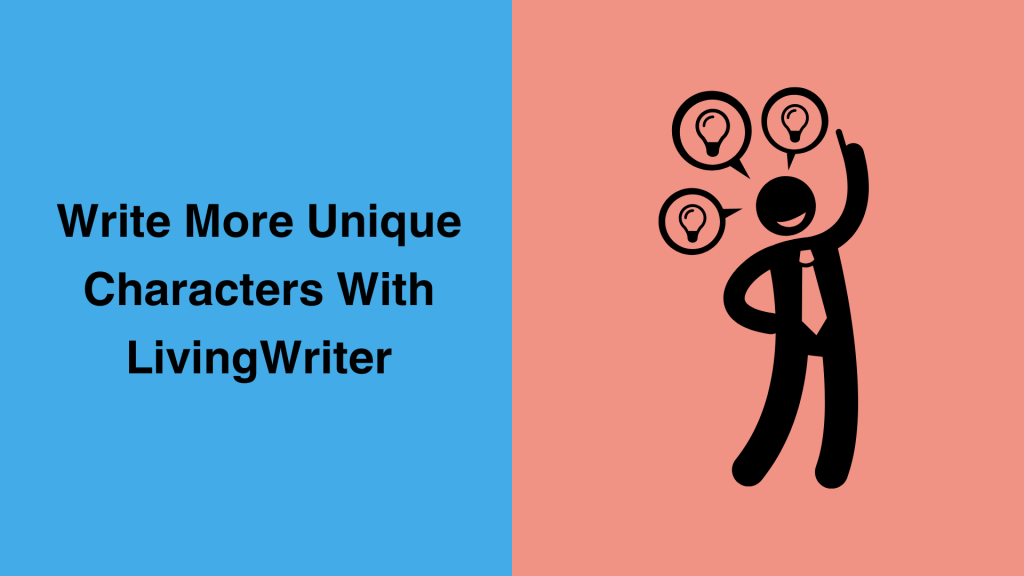
Creating standout characters is crucial for making your story memorable. Yet, the challenge of avoiding cliches and ensuring your characters resonate with readers is real. Enter LivingWriter – your solution to the character creation struggle. Bid farewell to those cookie-cutter traits. Today, we’ll cover how LivingWriter transforms the process, making fresh character creation a breeze for a more unique and memorable narrative.
LivingWriter helps create unique characters by offering you several features capable of creating and refining characters. These include:
- Character AI Tools
- Manuscript Chat Features To Refine Characters
- Character Image Capabilities
- Integration Of Characters Into The Manuscript
Some features, such as character AI, might sound familiar, but LivingWriter has cutting-edge stuff you won’t find anywhere else. So, I’ll be breaking down each of the features mentioned above (plus more) in detail and showing how to write unique characters with LivingWriter. Without further ado, let’s get started.
How To Write Unique Characters With LivingWriter
Most (but not all) fiction is character-driven. And, of course, as writers, we want to write good quality characters that support and drive the plot. Usually, this means a character that is unique in some way. After all, humans are incredibly complex and varied, and many of us seek to capture that standout, memorable, “one of a kind” feel for our characters.
But it’s often not easy to write unique characters – In general, we know to avoid stereotypes, flat motivations, and the more overused tropes. But this problem could manifest as struggling for variance between character styles in your work from book to book, breaking the mold of your genre, or simply thinking outside the box.
Here’s where LivingWriter comes in!
Character AI
AI can be an invaluable tool for creating better characters. And I know what you’re thinking, “Doesn’t using AI take all the soul out of the story and make it feel mechanical!?” Some, yes. But not our AI. LivingWriter AI is designed to help writers do their best work, not write it for them.
You May Also Like: How To Create AI Elements on LivingWriter
With the click of a few buttons, you can give the software some basic info on what you’re looking for and get a character profile back in a matter of moments.
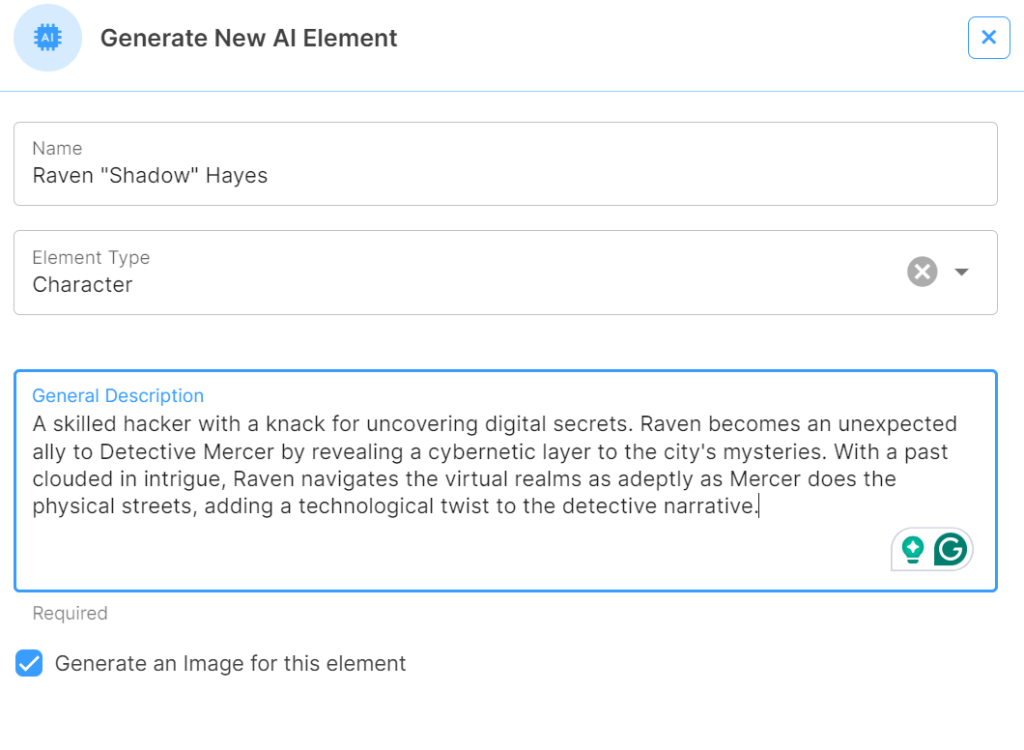
As you can see, you can describe things with plain language in as little detail as you’d like. Once your info is in, click generate, and you’re set. Here’s the character I got from the description above:
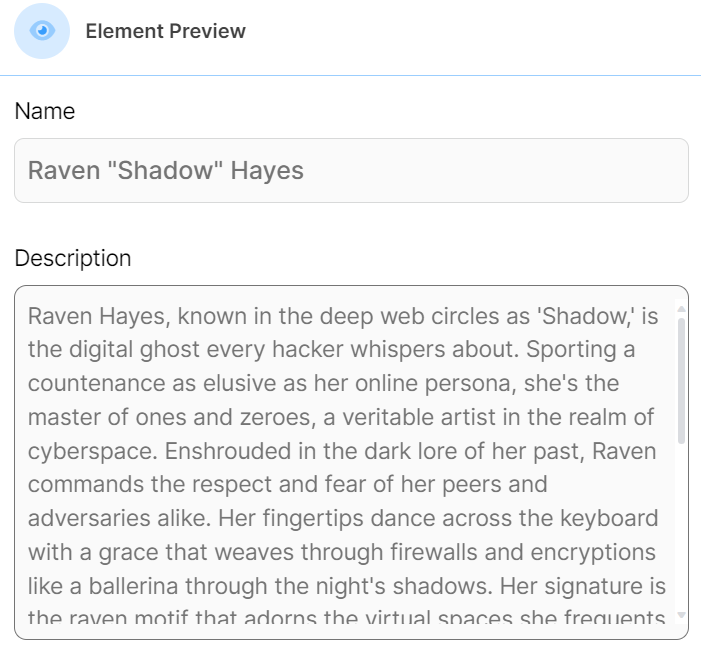
The AI expands upon the info provided. This example includes the fact that she has a dark past and is respected by peers and enemies. It’s giving some substance to the character while leaving the exact details up to the author. Further down in the description, it added:
“Her signature is the raven motif that adorns the virtual spaces she frequents, symbolizing her watchful presence and intelligence. This avian calling card caught the attention of Detective Mercer, pulling her from the nebulous anonymity into an uneasy partnership.”
These descriptions help to start setting the foundation for things like backstory, relationships, distinctive traits, and even some symbolism. It also begins to set the stage for you to develop clear motivations for the character and an arc for them to evolve and grow past their flaws.
Again, without actually writing your story for you. Instead, you get the building blocks for a unique character that you can be sure fits your vision and style as you add details.
Character Images
When you create an AI character, you can also opt to have it make an image for it. The high-quality and unique images can add a ton of personality to a character. After all, a picture is worth 1000 words. So, I highly recommend you try including an image and see if it sparks creative ideas for the character that you wouldn’t have thought about otherwise.

You can add numerous images of your own to your character profiles, too, allowing you to create galleries of your characters.

Character Feedback
Once you’ve created some characters and begun writing your story, you can chat directly with your manuscript. The manuscript chat features allow you to ask research-based, theoretical, or logistical questions about your plot and characters.
You May Also Like: How LivingWriter’s AI manuscript Chat works
The chat understands your manuscript and everything within and can offer you feedback tailored directly to your story. So, you can ask things like, “How do I make Dr. Isabella Morgan more interesting?” and it will give you advice on that specific character in the context of your story.
For example, I asked, “Are the mentions of Alex’s past intriguing enough? If not, what can I do to improve them?”
And here was the response I got:
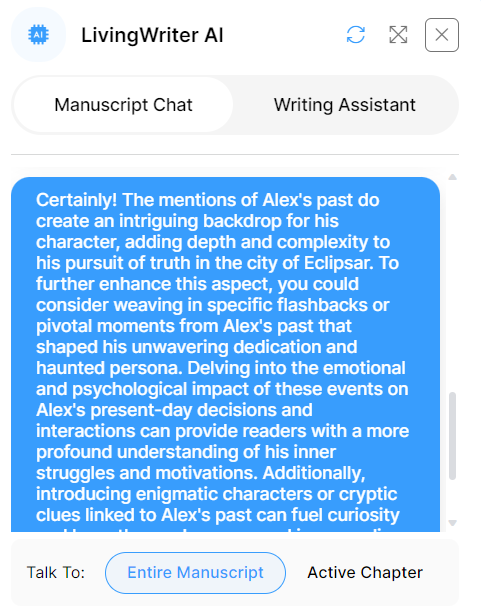
Insight like this helps to create better, more well-rounded characters. You also receive practical advice on achieving certain things with your character. This gives you the tools for improved characters and plots, and you can also ask directly about uniqueness.
I asked, “How can I make Vincent Caldwell more unique and dynamic?” And again, get advice on what to do and some ways to do it:
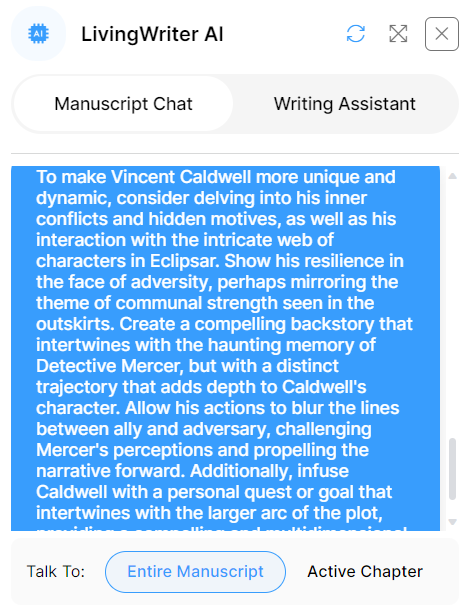
Integrated Characters
Whenever you type the name of a character or element into your manuscript, it’s intuitively pulled in like a link. Clicking the highlighted text will take you to a rundown of the character where you can see (and edit) their description, add nicknames, and provide info about their relationships with other characters.
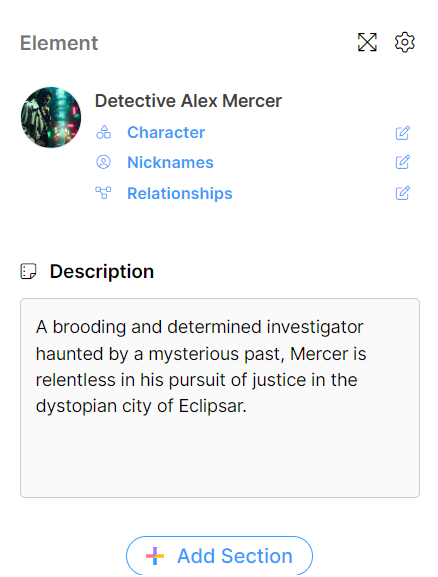
In my experience, having your characters come to life in your manuscript keeps their evolution at the forefront of your mind as you write. Each time you type their name, you’ll have access to all their info and the chance to refine them if needed.
A character that evolves throughout the story is probably a good character. And these features help you keep your finger on the pulse of your good guys, bad guys, and everyone in between.
Conclusion
LivingWriter is your all-in-one, jack-of-all-trades writing software, and it has several features to help you build more unique characters for your work. Depending on the current level of your writing, unlocking the ability to create more relatable, dynamic characters can instantly make your fiction more engaging. So, get out there and get to work on your story. Until next time, happy writing.